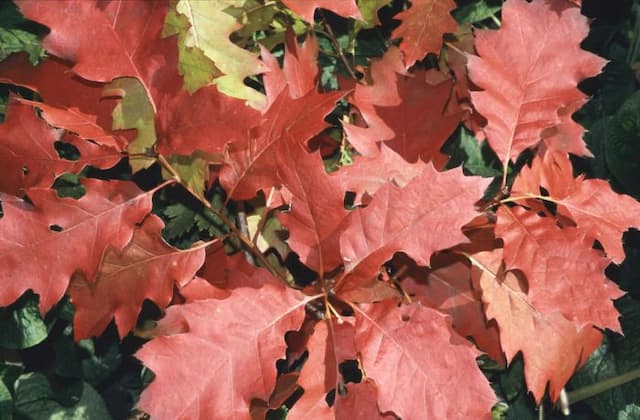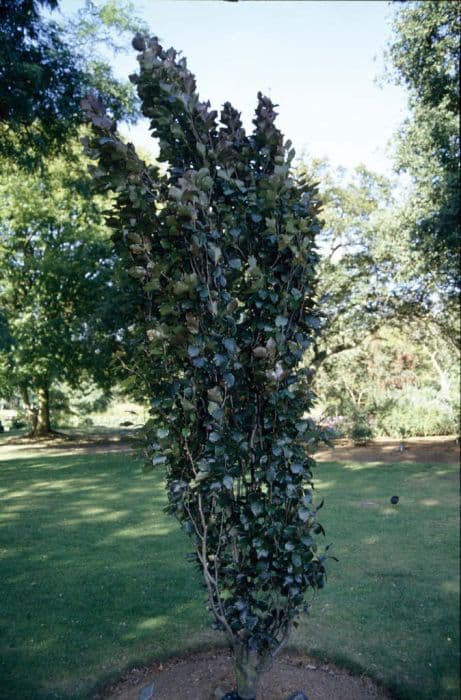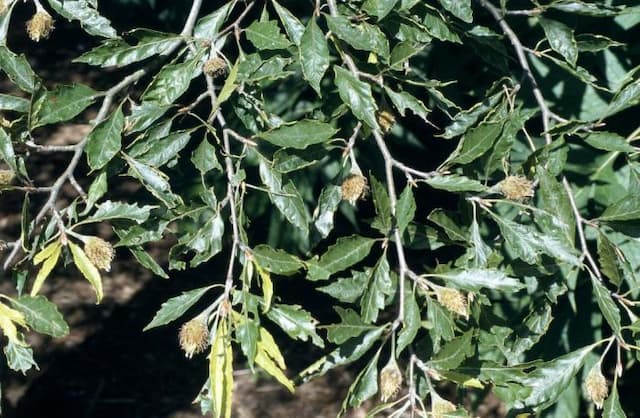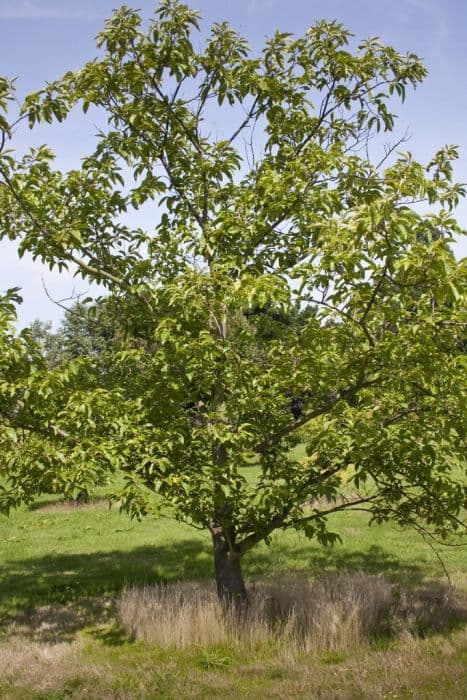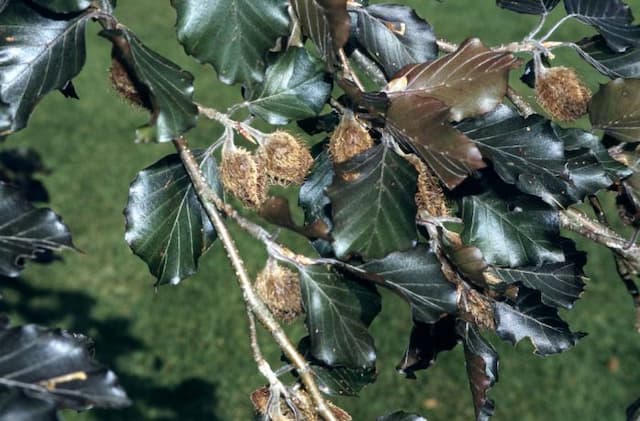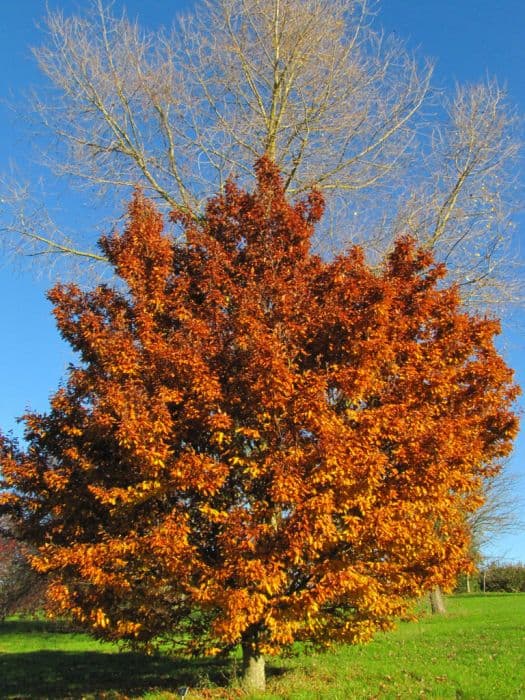Algerian oak Quercus canariensis

ABOUT
Quercus canariensis, commonly known as the Algerian oak, is distinguished by its large and robust appearance. The leaves of this oak are particularly noteworthy; they are lustrous and dark green on the upper surface, with a paler, somewhat hairy underside. The leaf shape exhibits deep, rounded lobes, giving them a uniquely scalloped edge. In the fall, the foliage does not drastically change color and typically remains on the tree until the new growth cycle. The Algerian oak produces acorns, which are noteworthy for their size and shape. They grow in a cup-like structure known as a cupule, which may feature scales that provide texture. The acorns themselves are ovoid, or egg-shaped, and encapsulated by the cupule which only covers part of the fruit. The bark of the Algerian oak is another characteristic feature, providing a rugged texture to the tree. The bark often has grooves and ridges, presenting a pattern that can be appealing to the eye. This tree also bears flowers, although they are not as showy as some other flowering plants. The male flowers take the form of catkins and hang loosely from the branches, while the female flowers are less conspicuous. As an evergreen, the Algerian oak maintains its leafy presence throughout the year, contributing to its lush and vibrant appearance. The tree's overall form is rounded with a spreading canopy that can provide generous shade. This, combined with its handsome leaves and textured bark, makes it a visually striking oak variety irrespective of its size.
About this plant
 Names
NamesSynonyms
Algerian Oak, Canary Oak, Mirbeck's Oak
Common names
Quercus mirbeckii, Quercus canariensis var. africana, Quercus canariensis var. mirbeckii, Quercus canariensis var. webbii, Quercus austrocaledonica, Quercus vexans.
 Toxicity
ToxicityTo humans
The plant Quercus canariensis, commonly known as Algerian oak, is not generally considered highly toxic to humans. However, like other members of the oak family, it produces acorns and oak leaves that contain tannins. Ingesting large quantities of these tannins can lead to gastrointestinal distress, such as stomach pain, nausea, vomiting, and diarrhea. Rarely, severe poisoning can cause more concerning symptoms such as kidney damage, although this is uncommon and typically associated with consuming significant amounts of acorn or young foliage.
To pets
The plant Quercus canariensis, known as Algerian oak, has parts, such as acorns and leaves, that can be toxic to pets, especially dogs and livestock, if consumed in large amounts. The primary toxic components are tannins and gallotannins, which can lead to gastrointestinal upset with symptoms like vomiting, diarrhea, and abdominal pain. In severe cases, when large quantities are ingested, kidney damage, dehydration, and even life-threatening conditions may occur. Close observation and veterinary attention are recommended if a pet ingests a significant amount of this plant material.
 Characteristics
CharacteristicsLife cycle
Perennials
Foliage type
Evergreen
Color of leaves
Green
Height
65 feet 20 meters
Spread
60 feet 18 meters
Plant type
Tree
Hardiness zones
7
Native area
Mediterranean
Benefits
 General Benefits
General Benefits- Shade Offering: Quercus canariensis, commonly known as the Algerian oak, can grow to a considerable size, providing ample shade in landscaped areas and parks.
- Wildlife Habitat: The tree supports diverse fauna, serving as a habitat for birds and other creatures which nest and feed on the acorns.
- Aesthetic Value: With a broad, rounded crown and attractive foliage, the Algerian oak adds beauty and grandeur to the landscape.
- Erosion Control: The extensive root system helps stabilize the soil, reducing erosion on slopes and in natural areas.
- Timber Production: The wood is valued for its durability and is often used in carpentry, construction, and for producing decorative veneers.
- Carbon Sequestration: Like many large trees, the Algerian oak captures carbon dioxide from the atmosphere, helping mitigate the effects of climate change.
- Support for Biodiversity: The tree plays a role in maintaining ecological balance by supporting a variety of plant and animal species in its ecosystem.
- Cultural Significance: It holds historical and cultural importance in some regions, being a part of landscapes and local heritage.
 Medical Properties
Medical PropertiesThis plant is not used for medical purposes.
 Air-purifying Qualities
Air-purifying QualitiesThis plant is not specifically known for air purifying qualities.
 Other Uses
Other Uses- The wood of Algerian oak is highly valued for veneer production, being used for decorative panels and fine furniture due to its attractive grain and texture.
- Algerian oak acorns can be ground into flour after leaching, which can then be used for baking, adding a nutty flavor to bread and other foods.
- The bark of Algerian oak has been traditionally used in tanning leather, providing an important source of tannins for the production of high-quality leather goods.
- The tree's substantial size and dense canopy make it an excellent shade tree in parks and large gardens, offering a cool refuge during hot summer days.
- As a large and robust tree, it is sometimes planted as a windbreak or to prevent soil erosion on slopes and banks due to its extensive root system.
- The Algerian oak is a host plant for various species of truffles, which form symbiotic relationships with the tree's roots and are a valuable and sought-after culinary delicacy.
- The leaves of Algerian oak can be used as a natural dye for fabrics, yielding colors in the brown and tan spectrum.
- In some cultures, the wood shavings of Algerian oak are used in smoking meats to impart a distinct flavor that cannot be achieved with other types of wood.
- The acorns of Algerian oak are sometimes used in artisanal crafts and jewelry, either whole or carved, due to their unique shape and texture.
- In certain regions, fallen leaves from the Algerian oak are collected and used as mulch in gardening and landscaping to retain soil moisture and prevent weed growth.
Interesting Facts
 Feng Shui
Feng ShuiThe Algerian oak is not used in Feng Shui practice.
 Zodiac Sign Compitability
Zodiac Sign CompitabilityThe Algerian oak is not used in astrology practice.
 Plant Symbolism
Plant Symbolism- Strength: The Algerian oak, being a variety of oak tree, symbolizes strength due to its hardy and robust nature.
- Endurance: This tree is known for its ability to live for many years, which makes it a symbol of endurance and longevity.
- Wisdom: Oaks are often associated with wisdom because they grow slowly and live a long time, representing the accumulation of knowledge over time.
- Nobility: The stature and grandeur of the Algerian oak confer a sense of nobility and dignity.
- Stability: The deep roots and solid trunk of the Algerian oak represent stability and groundedness.
- Heritage and ancestry: Because of their longevity, oaks are often linked to heritage and the passage of time, embodying a connection to one's roots and ancestors.
 Water
WaterThe Algerian Oak, which is the common name for Quercus canariensis, requires consistent moisture, especially during its growing season in spring and summer, to establish a deep root system. During these months, water the tree deeply once a week with about 10 gallons per inch of trunk diameter. In the fall and winter, you can decrease the watering frequency as the tree's growth slows down. Ensure the soil remains moist but not waterlogged, as too much water can lead to root rot. Adjust the watering schedule during periods of drought or excessive rain.
 Light
LightThe Algerian Oak thrives best in full sun conditions where it can receive direct sunlight for at least six hours a day. It is well-suited for open landscapes or large backyards where it can receive unobstructed sunlight. Partial shade is also tolerable, but the tree's growth may not be as vigorous.
 Temperature
TemperatureAlgerian Oaks are hardy and can withstand a wide range of temperature conditions. They can survive brief periods as low as 20°F and as high as 100°F. However, the ideal temperature range for this oak is between 60°F and 80°F. Proper mulching can help to regulate soil temperature and protect the roots in extreme conditions.
 Pruning
PruningPruning the Algerian Oak is essential to maintain its health and structure. Prune in the dormant season, typically late winter before new growth begins, to remove any dead, damaged, or diseased branches. Thinning out the canopy every few years allows light and air to reach the inner branches, promoting a healthier tree. Pruning should be done as needed, but not excessively, to preserve the tree's natural form.
 Cleaning
CleaningAs needed
 Soil
SoilThe Algerian oak prefers a soil mix that is well-draining with a slightly acidic to neutral pH of 5.5 to 7.0. A blend of loamy soil, compost, and sand or perlite will create the ideal environment for this tree to thrive. Regularly check the pH levels to maintain optimal conditions.
 Repotting
RepottingAlgerian oaks are large trees and seldom need repotting; they are typically planted directly in the ground. As a sapling, it may be repotted every 2-3 years until it is large enough to be planted permanently outdoors.
 Humidity & Misting
Humidity & MistingAlgerian oaks are tolerant of a range of humidity levels but prefer moderate to high humidity. They thrive in outdoor conditions where natural humidity provides the moisture they need without the necessity of artificial augmentation.
 Suitable locations
Suitable locationsIndoor
Not suited for indoor growth; reach large sizes.
Outdoor
Plant in well-draining soil, full sun, water deeply.
Hardiness zone
7-10 USDA
 Life cycle
Life cycleThe life of Algerian oak (Quercus canariensis) begins with acorn germination, where the seedling develops roots and a shoot that emerges from the soil. As a sapling, the tree slowly establishes a strong root system and begins to grow vertically, with its leaves starting to photosynthesize to provide energy for growth. It matures over several decades, developing a broad, thick trunk and a wide canopy that supports biodiversity and produces large quantities of acorns annually. The mature Algerian oak can withstand drought and is adapted to Mediterranean climates, reaching reproductive maturity at about 20 to 30 years. The tree's lifespan can extend over hundreds of years, during which it will continuously reproduce each fall, dropping acorns that give rise to future generations. Eventually, older trees may succumb to environmental stresses, diseases, or human activity, completing their life cycle.
 Propogation
PropogationPropogation time
Spring-Early Summer
The Algerian oak, Quercus canariensis, is commonly propagated by acorns, which is a form of sexual propagation. The optimal time to collect acorns for propagation is when they naturally fall from the tree, which typically occurs in the autumn. The collected acorns should be planted soon after collection as they lose viability quickly when stored. To propagate Algerian oaks from acorns, the nuts should be sown about 1 to 2 inches deep into a well-draining soil mix. It is crucial to keep the soil moist but not waterlogged to encourage germination. Germination can take anywhere from one month to a year, and it is not uncommon for acorns to require a cold stratification period to break dormancy. After germination, seedlings can be grown in pots before being transplanted to their final location in the landscape.
